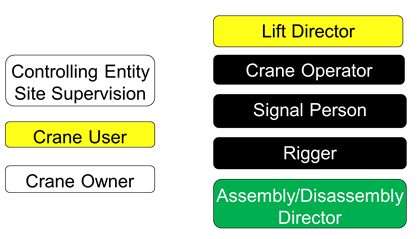First in a series of related articles reviewing each of the roles that have been identified when working with cranes, explaining the responsibilities, defining the training requirements, as well as outlining the documentation requirements.
April 2021—Often the discussion around responsibilities of on-site personnel for cranes does not occur until an incident happens. Unfortunately, at that point, the finger pointing begins and responses such as “We aren’t crane experts! That is why we hired a crane company!” are all too common.
First, the fantastic news! Unlike many other safety regulations and standards, the responsibilities of on-site personnel for cranes have been clearly defined. This provides the industry a great tool and starting foundation from which to build. However, the responsibilities come from multiple sources so putting everything in one easy to use guide can be a bit difficult, especially when adding in the additional layers of complexity of vertical standards, state plans, local jurisdictions, and site plans.
While state plans, local jurisdictions, and site plans can be more stringent, this series is going to focus on industry standards and federal regulations. Regarding the federal regulations, we will focus on the Crane and Derricks in Construction Standards (29 CFR 1926 Subpart CC), as they are the most stringent on a federal level.
State plan states are required to have regulations that are at least as rigorous as federal OSHA’s. However, regarding cranes, some states have more restrictive regulations regarding things such as the qualifications of a crane, an operator, a rigger, a signal person, or an assembly/disassembly (A/D) director. If working in one of these states, it would be important to gain an understanding of that state’s approach to cranes and which, if any, areas it may be more restrictive than OSHA.
With regard to industry standards, the industry relies on the ASME B30 series. While much recent attention has been paid to regulation development on a state and federal level, ASME continues to update the industry consensus standards every three to five years. Additionally, ASME’s panel of diverse industry experts respond to questions and inquiries, making these documents continually evolving. Lastly, and perhaps most importantly, ASME standards have a much broader scope than their regulatory counterparts and apply to far more industries and locations.
Additionally, there are some worksites that have defined crane-related items in a more prescriptive manner. In these cases, it would be important to understand and comply with such measures.
Now that we have delineated the regulations and standards that will be discussed, it is important to define three of the terms related to qualification of individuals: competent, qualified, and certified. OSHA 1926.1401 defines these as:
- Competent—One who is capable of identifying existing and predictable hazards in the surroundings or working conditions which are unsanitary, hazardous, or dangerous to employees and who has authorization to take prompt corrective measures to eliminate them.
- Certified—A person who meets the testing requirements by a nationally recognized third party with regard to the subject matter.
- Qualified—A person who, by possession of a recognized degree, certificate, or professional standing, or who by extensive knowledge, training, and experience, successfully demonstrated the ability to solve/resolve problems relating to the subject matter, the work, or the project.
The difference in these terms is critical to understand. Too often these terms are being mixed up and used interchangeably when they mean very different things. Proper use of these terms is vital when discussing responsibilities.
When referring to testing requirements, “certified” is the most stringent and requires tests by a nationally recognized third party, such as NCCCO. “Qualified” typically requires some type of testing; however, this can be done by the employer and is not required to meet national testing standards. For “competent” qualification, it is more about the ability, experience, and authorization rather than demonstrating the ability to solve and resolve problems through a test.
Below is a chart that we will use to work our way through the areas of responsibility:

On the left side are roles that do not have any requirements listed for qualification (e.g. competent, certified, or qualified); however, the roles on the right side do have requirements that we will be reviewing. The roles in yellow are defined only in ASME and not in OSHA; the role in green is specifically defined in OSHA while ASME is less direct.
By Thom Sicklesteel, CEO of the National Commission for the Certification of Crane Operators (NCCCO), a voting member of ASME B30.5, and an alternate on B30.
View the other articles in this series: